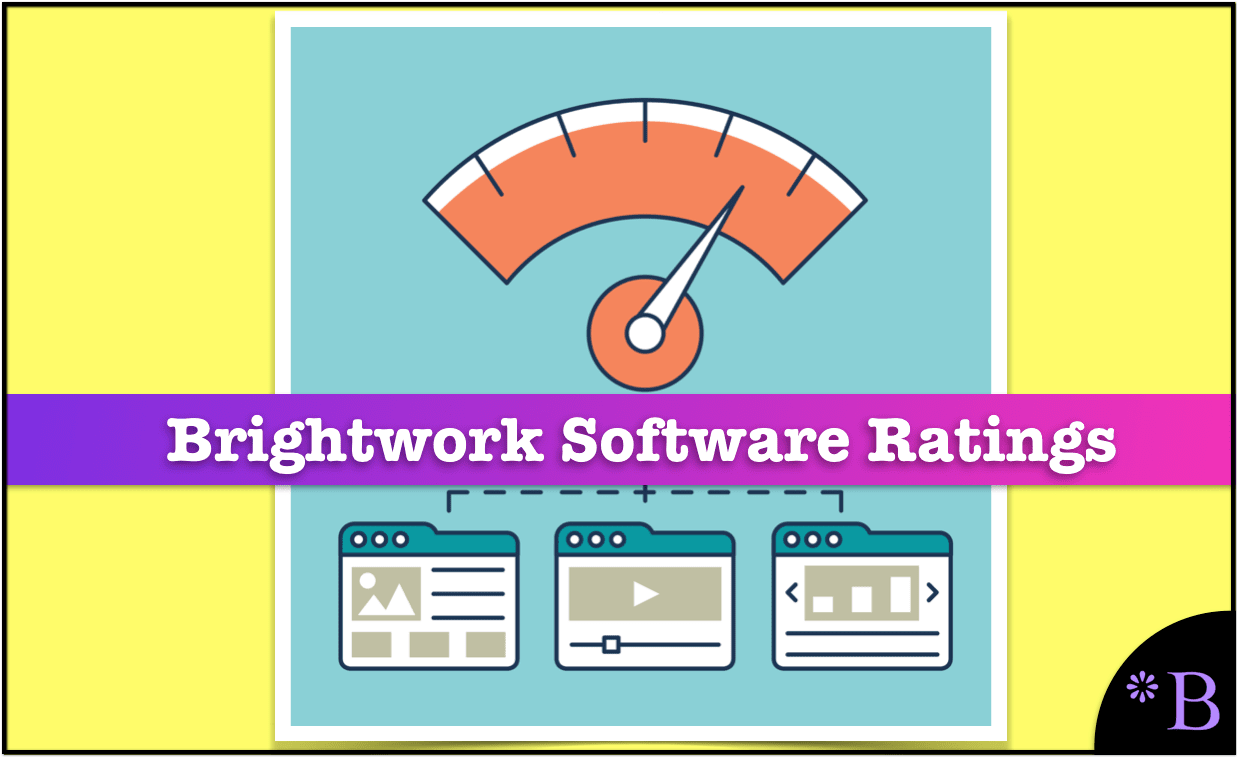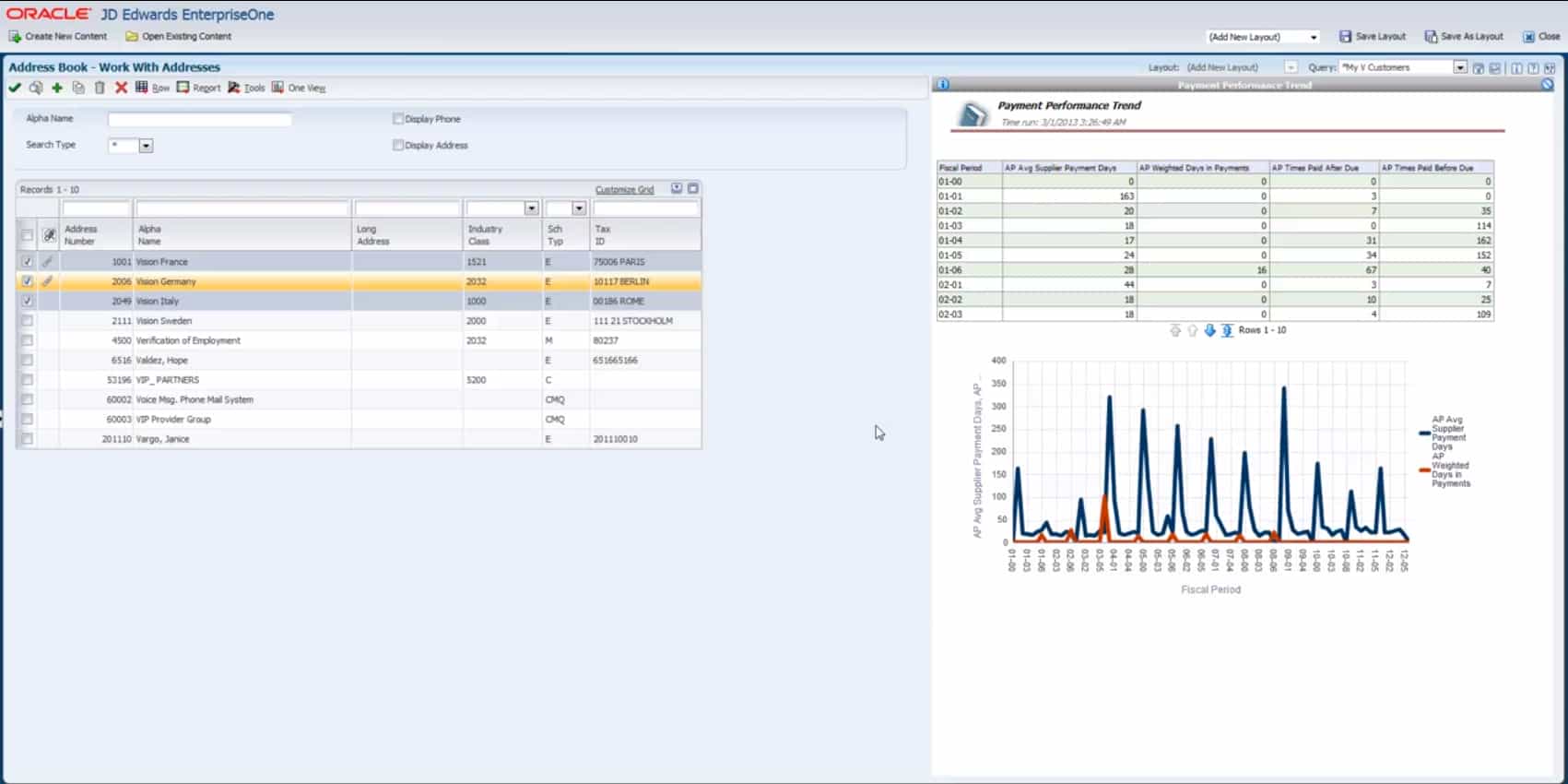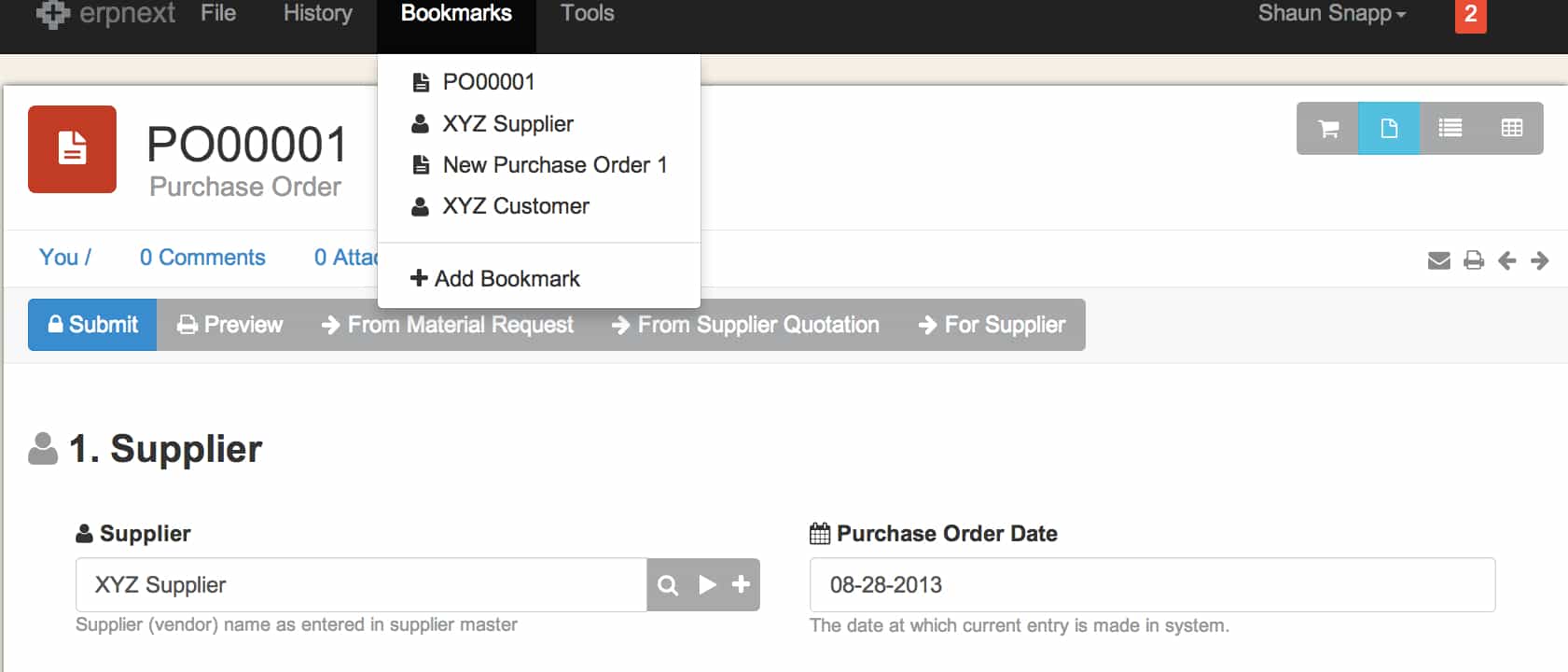Executive Summary
- This is the Brightwork Research & Analysis software rating series.
- We rate both the software and estimate the risk of implementing each application.
MUFI Rating & Risk for JD Edwards EnterpriseOne
MUFI: Maintainability, Usability, Functionality, Implement ability
Vendor: Oracle (Select For Vendor Profile)
Oracle second-largest ERP software vendor with 13% of the ERP market. Unlike SAP, Oracle’s software heritage is not in ERP but is in databases and this why all of its ERP software was acquired. Oracle went through a transition where they moved from being primarily a database company to being an overall enterprise software company, and having a competitive ERP system was a significant part of that transformation. There was no reason for doing this, as most ERP systems can run on multiple databases. Still, it was an effective use of leveraging preexisting sales contacts to sell more software into existing accounts. Now that SAP has acquired Sybase, both Oracle, and SAP attempt to get their customers to use their database when they purchase their applications. This has nothing little to do with any technological benefit to doing so, but is related to competition between these two giants and is entirely based upon account control.
However, still Oracle JD Edwards Enterprise One has one of the best user satisfaction levels in the ERP software category.
Application Detail
Oracle JD Edwards Enterprise One competes directly with SAP ECC. It lags SAP ECC the breadth of its functionality (although a much higher percentage of it is usable than with SAP), and Enterprise One has a much better user interface.
Unlike in the SAPGUI, in Oracle, the user interface elements can in some cases be moved around the screen. While better than SAP ECC, Oracle’s JD Edwards Enterprise One user interface is still quite dated compared to almost every other ERP system.
Speaking of the user interface, while SAP and Oracle tier 1 ERP systems are the most expensive applications in the ERP space, both user interfaces considerably lag ERPNext, which is inexpensive with one of the lowest TCO’s of any ERP system that we analyze.
The superiority of the user interface is clear from the screenshot below:
Some of the modern ERP systems allow the user to take advantage of easy to use bookmarks – and they have breadcrumbs along the top, which tells the user where they are in the process. These systems are easy for both experienced and novices to use because the business process is explained right in the application.
When one uses either SAP or Oracle ERP systems, it seems like getting in a time machine when compared to the newer ERP applications. Both SAP and Oracle are offering ERP software to business which is seriously dated, and which has serious negative implications for the productivity of companies that purchase it. The only reason that is not more broadly known is that the major consulting companies and IT analysts – both with financial conflicts of interest obstruct buyers from knowing this by offering simplistic platitudes related to “standards” and “core” or “non-core functionality.”
EnterpriseOne is also considerably less expensive in the total cost of ownership than SAP ERP. Some of the reasons for this is that its infrastructure is more modern, and it is easier to integrate to Oracle JD Edwards EnterpriseOne than SAP ECC. However, Oracle follows an identical sales strategy to SAP, proposing that companies can if they wish to use what amounts to a bunch mediocre combination of functionality. If a company is intent on going with a tier 1 ERP system, the decision between SAP and Oracle is very simple – those companies wanting a lower TCO and faster implementation will want to go with JD Edwards Enterprise One.
The major consulting companies heavily parasitize both solutions, which means that generally, both applications tend to involve a major consulting company, increasing costs and reducing the likelihood of implementation success. It will also be a trying experience as the partner of the major consulting company will attempt to influence other IT decisions and purchase of the “customer.” This strategy is referred to as “penetrate and radiate,” that is to use any project to become a “trusted advisor” and to sell more services into the account.
However, with so many better options in the market than either SAP ECC or Oracle JD Edwards Enterprise One, it’s difficult to see how this strategy makes any sense anymore. This is explained in the book The Real Story Behind ERP: Separating Fact from Fiction. The TCO of using SAP and Oracle ‘s ERP as the centrepiece to the enterprise software strategy is shown in our Solution Architecture Packages, and the results would make a person logically question why anyone would follow this strategy.
MUFI Scores
All scores out of a possible 10.
MUFI Scores
- Ma. = Maintainability
- Us. = Usability
- Fu. = Functionality
- Im. = Implementability
| App | Ma. | Us. | Ft. | Im. | Cat. |
|---|---|---|---|---|---|
| Average Score for Big ERP | 5.1 | 4.8 | 5.2 | 5.4 | Big ERP |
| Average Score for CRM | 6.2 | 6.2 | 5.1 | 5.9 | CRM |
| Average Score for Small and Medium ERP | 8.3 | 8 | 6.7 | 8.5 | Small and Medium ERP |
| Average Score for Finance | 8.8 | 8.8 | 8 | 8.8 | Finance |
| Average Score for Demand Planning | 7.6 | 7.2 | 7 | 7.1 | Demand Planning |
| Average Score for Supply Planning | 6.7 | 6.9 | 7 | 6.8 | Supply Planning |
| Average Score for Production Planning | 6.8 | 6.9 | 7 | 6.9 | Production Planning |
| Average Score for BI Heavy | 5.5 | 5.3 | 6.9 | 5.3 | BI Heavy |
| Average Score for PLM | 7 | 7.2 | 6.8 | 7.3 | PLM |
| Average Score for BI Light | 7.7 | 8.7 | 9 | 8.3 | BI Light |
| Arena Solutions Arena PLM | 10 | 10 | 10 | 10 | PLM |
| AspenTech AspenOne | 4 | 8 | 10 | 7 | Production Planning |
| Birst | 8 | 8.5 | 10 | 8 | BI Light |
| ERPNext | 10 | 10 | 7.5 | 10 | Small and Medium ERP |
| Delfoi Planner | 8 | 6 | 6.5 | 7 | Production Planning |
| Demand Works Smoothie SP | 9 | 10 | 7 | 10 | Supply Planning |
| Hamilton Grant RM | 10 | 9 | 8.5 | 9 | PLM |
| IBM Cognos | 2.7 | 3 | 1.5 | 3 | BI Heavy |
| Infor Epiphany | 7 | 8 | 6 | 5 | CRM |
| Infor Lawson | 8 | 7 | 6 | 7 | Big ERP |
| Intuit QuickBooks Enterprise Solutions | 9 | 9 | 5 | 9 | Finance |
| JDA DM | 9 | 7.5 | 8 | 8 | Demand Planning |
| Microsoft Dynamics CRM | 2 | 3 | 2 | 2 | CRM |
| NetSuite CRM | 6 | 4 | 3 | 3 | CRM |
| Netsuite OneWorld | 7 | 7 | 8 | 8 | Big ERP |
| OpenERP | 7 | 8 | 8.5 | 8 | 7 |
| Oracle BI | 4 | 4 | 3 | 6 | BI Heavy |
| Oracle CRM On Demand | 4 | 5 | 3 | 5 | CRM |
| Oracle Demantra | 5 | 3 | 3.5 | 4.5 | Demand Planning |
| Oracle JD Edwards World | 4 | 1 | 3 | 6 | Big ERP |
| Oracle RightNow | 6 | 7 | 4 | 5 | CRM |
| PlanetTogether Galaxy APS | 10 | 10 | 10 | 10 | Production Planning |
| Preactor | 8 | 7 | 3 | 7 | Production Planning |
| QlikTech QlikView | 9 | 9 | 10 | 9 | BI Light |
| Rootstock | 9 | 8 | 9 | 9 | Small and Medium ERP |
| Sage X3 | 8 | 8 | 7 | 8 | Big ERP |
| Salesforce Enterprise | 8 | 8.5 | 9 | 7.5 | CRM |
| SAP APO DP | 3 | 4 | 3 | 2 | Demand Planning |
| SAP APO PP/DS | 2 | 2 | 4 | 3 | Production Planning |
| SAP APO SNP | 3 | 4 | 8 | 4 | Supply Planning |
| SAP BI/BW | 1.5 | 2 | 4 | 2 | BI Heavy |
| SAP Business Objects | 3 | 2.5 | 7 | 3 | BI Heavy |
| SAP CRM | 4 | 3 | 6 | 4 | CRM |
| SAP ECC | 3 | 3 | 6.5 | 3 | Big ERP |
| SAP PLM | 1 | 2.5 | 2 | 3 | PLM |
| SAP SmartOps | 4 | 4 | 7 | 5.5 | Supply Planning |
| SAS BI | 6.5 | 7 | 9 | 6 | BI Heavy |
| SAS Demand Driven Forecasting | 7 | 8 | 9 | 7 | Demand Planning |
| Tableau (BI) | 9 | 10 | 10 | 10 | BI Light |
| Tableau (Forecasting) | 10 | 8 | 5 | 9 | Demand Planning |
| Teradata | 8 | 6.3 | 9.7 | 6 | BI Heavy |
| ToolsGroup SO99 (Forecasting) | 7 | 8 | 9 | 7 | Demand Planning |
| ToolsGroup SO99 (Supply) | 5 | 6 | 10 | 7 | Supply Planning |
Vendor and Application Risk
Oracle JD Edwards EnterpriseOne is on average the second-longest to implement all the ERP systems. As with SAP ECC, the flawed proposal regarding Oracle JD Edwards EnterpriseOne is that a company should implement the ERP application first, and then it will be in a better position to implement other applications. Another argument that JD Edwards EnterpriseOne has financial functionality that is highly differentiated is also false, with best of breed applications like Intacct exceeding SAP ECC’s financial module.
Likelihood of Implementation Success
This accounts for both the application and the vendor-specific risk. In our formula, the total implementation risk is application + vendor + buyer risk. The buyer specific risk could increase or decrease this overall likelihood and adjust the values that you see below.
Likelihood of Application Implementation Success and Failure
Search for the application in this table using the search bar in the upper right of the table.
| Application | Prob of Implementation Success | Prob of Implementation Failure |
|---|---|---|
| Actuate | 0.77 | 0.23 |
| SAP Smartops | 0.39 | 0.61 |
| NetSuite CRM | 0.46 | 0.54 |
| Sugar CRM | 0.62 | 0.48 |
| Base CRM | 0.91 | 0.09 |
| SAP CRM | 0.35 | 0.65 |
| Salesforce Enterprise | 0.72 | 0.28 |
| QlikTech QlikView | 0.82 | 0.18 |
| Tableau (BI) | 0.98 | 0.02 |
| SAP Crystal Reports | 0.46 | 0.54 |
| Brist | 0.83 | 0.17 |
| MicroStrategy | 0.7 | 0.3 |
| SAS BI | 0.76 | 0.24 |
| Oracle BI | 0.35 | 0.65 |
| IBM Cognos | 0.23 | 0.77 |
| Infor Epiphany | 0.58 | 0.42 |
| Microsoft Dynamics CRM | 0.26 | 0.74 |
| Oracle RightNow CRM | 0.41 | 0.59 |
| Oracle CRM On Demand | 0.36 | 0.64 |
| Teradata | 0.76 | 0.24 |
| SAP Business Objects | 0.32 | 0.68 |
| SAP BI/BW | 0.25 | 0.75 |
| SAP PLM | 0.29 | 0.71 |
| Hamilton Grant RM | 0.89 | 0.11 |
| Arena Solutions | 0.96 | 0.04 |
| Delfoi Planner | 0.7 | 0.3 |
| Preactor | 0.64 | 0.36 |
| PlanetTogether Galaxy APS | 0.96 | 0.04 |
| AspenTech AspenOne | 0.55 | 0.45 |
| SAP APO PP/DS | 0.27 | 0.73 |
| Demand Works Smoothie SP | 0.93 | 0.07 |
| ToolsGroup SO99 (Supply) | 0.82 | 0.18 |
| Demand Works Smoothie | 0.96 | 0.04 |
| Tableau (Forecasting) | 0.9 | 0.1 |
| SAS Demand Driven Forecasting | 0.82 | 0.18 |
| ToolsGroup SO99 (Forecasting) | 0.86 | 0.14 |
| JDA DM | 0.57 | 0.43 |
| Oracle Demantra | 0.33 | 0.67 |
| SAP APO DP | 0.28 | 0.72 |
| FinancialForce | 0.92 | 0.08 |
| Intacct | 0.98 | 0.02 |
| Intuit QB Enterprise | 0.8 | 0.2 |
| ERPNext | 0.9 | 0.1 |
| OpenERP | 0.78 | 0.22 |
| Rootstock | 0.91 | 0.09 |
| ProcessPro | 0.93 | 0.07 |
| Microsoft Dynamics AX | 0.4 | 0.6 |
| SAP Business One | 0.49 | 0.51 |
| Sage X3 | 0.62 | 0.38 |
| Infor Lawson | 0.58 | 0.42 |
| Epicor ERP | 0.4 | 0.6 |
| Oracle JD Edwards World | 0.31 | 0.69 |
| Oracle JD Edwards EnterpriseOne | 0.36 | 0.64 |
| SAP ERP ECC/R/3 | 0.32 | 0.68 |
| NetSuite OneWorld | 0.65 | 0.35 |
Risk Definition
See this link for more on our categorizations of risk. We also offer a Buyer Specific Risk Estimation as a service for those that want a comprehensive analysis.
Risk Management Approach
Oracle JD Edwards EnterpriseOne is a risky implementation. It is problematic these implementations tend to have so much breadth. Another major problem is that the major consulting companies primarily implement Oracle JD Edwards EnterpriseOne – and they treat their tier 1 ERP projects as cash cows – actively extending the projects to maximize their billable hours. The tier 1 software vendors have done very little to make their software more implementable and more usable.
The main objective should be to keep Oracle from “taking over the company,” and this is a challenge. SAP, like SAP and several other ERP vendors, uses ECC as a wedge to sell in what are often inappropriate applications to ERP customers using the faulty logic of integration costs savings. How badly this is for customers is covered in our Solution Architecture Packages). This is a strategy based on leveraging previous investments to influence future investments and is about harnessing the buyer into bad decisions. The best way to get value from SAP ECC is by controlling its scope and by controlling SAP to prevent them from taking over the company’s IT spend.
Finished With Your Analysis?
To go back to the Software Selection Package page for the Big ERP software category. Or go to this link to see other analytical products for Oracle JD Edwards EnterpriseOne.


